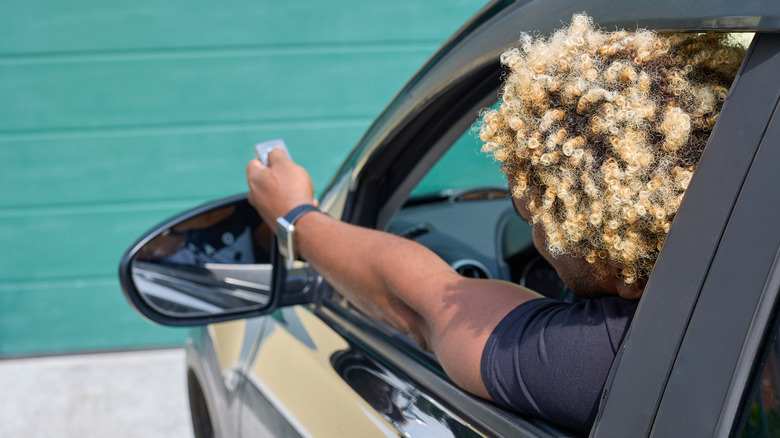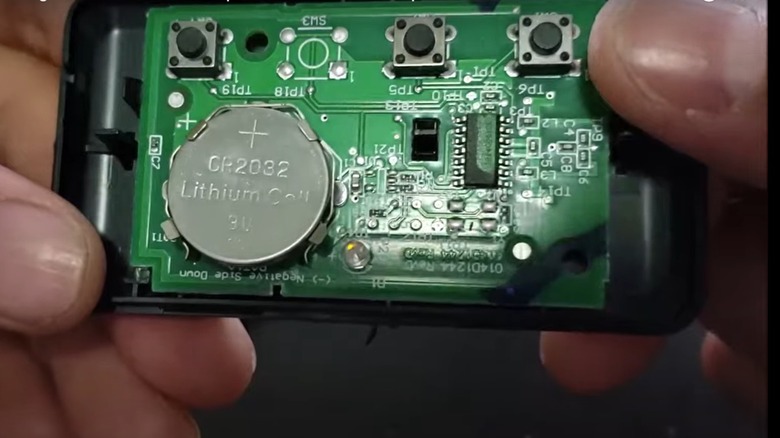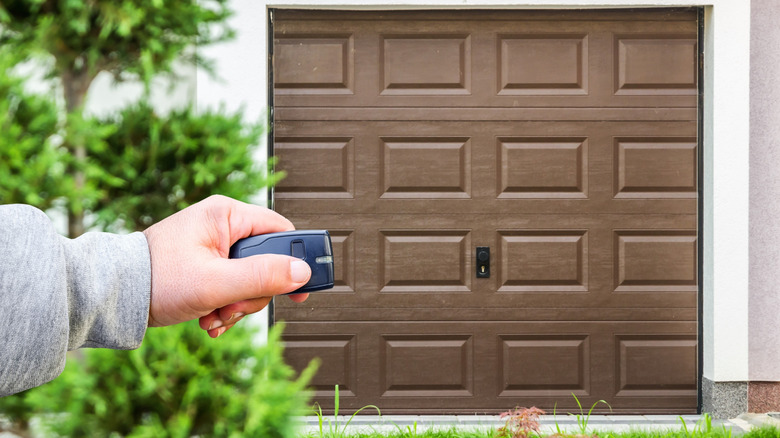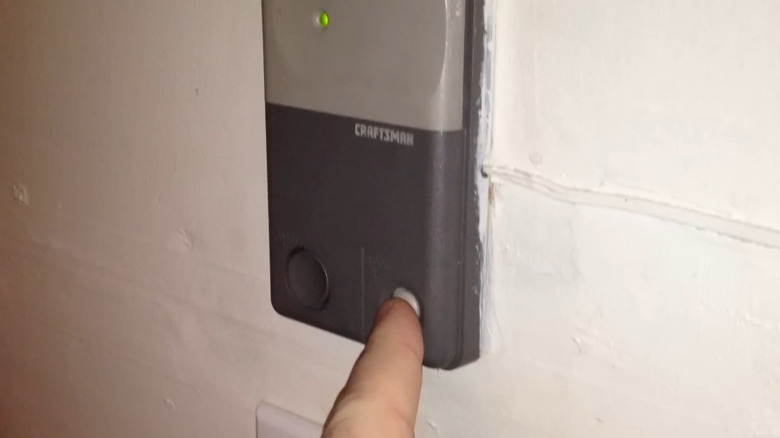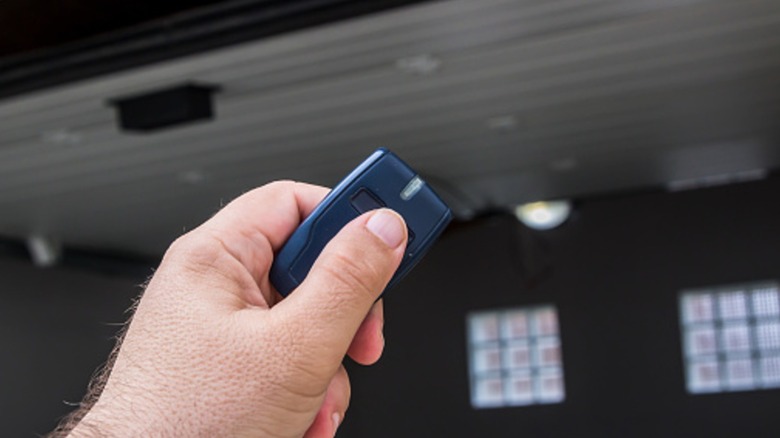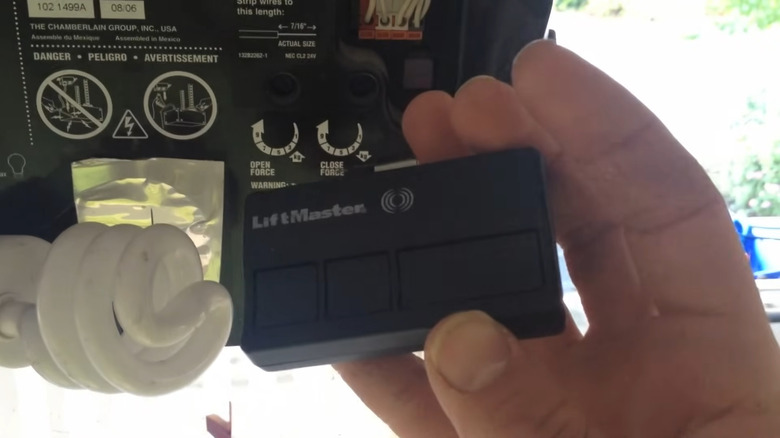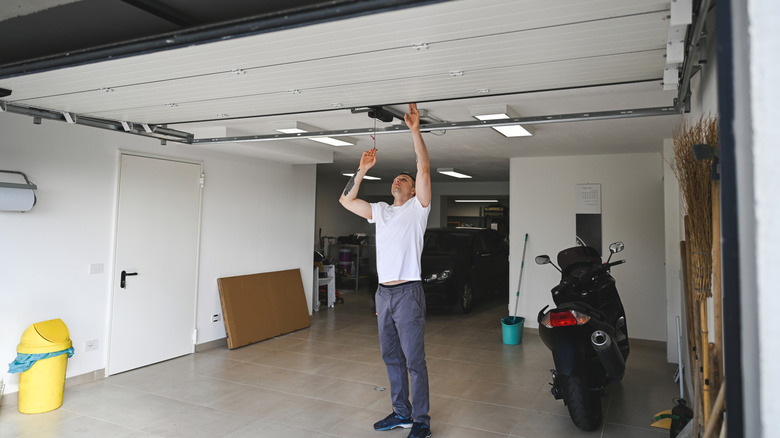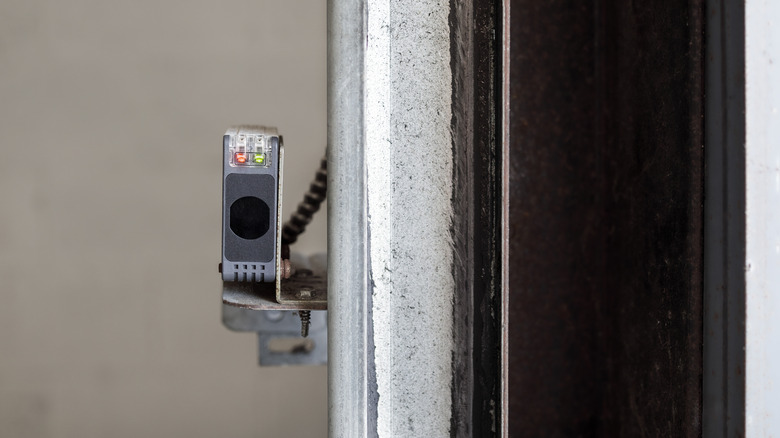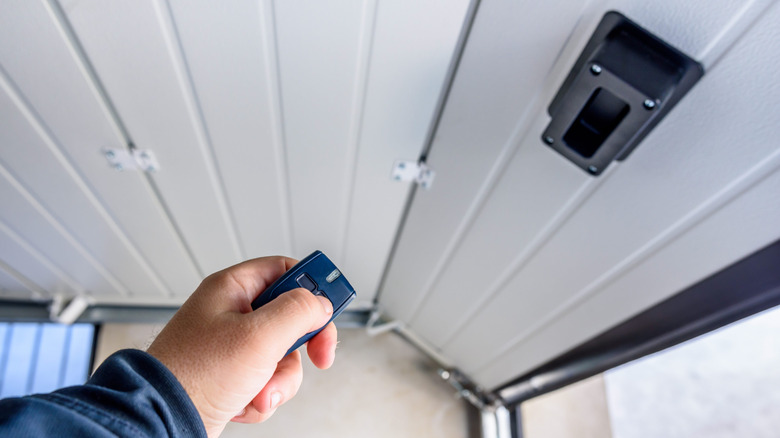Common Garage Door Opener Problems (& How To Fix Them)
We may receive a commission on purchases made from links.
Picture this. You pull into your driveway, exhausted after a long day at work. All you want to do is get inside so you can finally put your feet up. However, when you push the button on the remote to open your garage door, nothing happens. You try pushing it again, and the door still doesn't move at all. Remotes that open our garages at the push of a button offer such convenience. However, when they don't work, it can be exceedingly frustrating — and worrisome.
There are a few common issues that could be causing your troubles. Here, we'll explore some of the problems that can prevent the remote from working. While many general garage door repairs are costly, fixing the clicker can be a low-cost, DIY task with these tips.
The remote's batteries are weak or dead
We become so reliant on technology working as it should, that it can be easy to overlook simple explanations. Before you start worrying that you have a major issue on your hands because your clicker isn't working, start with the basics. These remotes are battery-powered, so the problem could simply be that the batteries are weak or dead.
To determine whether this is to blame, there are a few things you can try. First, verify that the door itself is actually responding by using the keypad on the side of the garage to try to open it. If this works, try pushing a button on the remote to see if the small light on it (if yours has one) illuminates. If it doesn't light up, the battery might be dead. Try replacing it (most remotes use a 1.5-volt battery, but you'll want to verify this before buying one for your unit).
If your garage door responds to the remote sporadically, the battery may not be completely dead yet. However, it may be very weak, which could be the reason for the intermittent issues. Replacing the battery could also help in these cases. The good news is that, even with daily use, these batteries tend to last for several years (sometimes up to five). So if replacing it resolves your issue, you shouldn't have to think about it again in the near future.
The radio frequency signal is disrupted
Garage door remotes communicate with the opener using a radio transmitter. If something interferes with the signal and prevents it from reaching the opener, then the garage door won't open. The frequency of a garage door remote is between 300 and 390 megahertz (MHz). Many other electronics in and around your home (think motion sensors) also operate within this same range. One of these devices may be disrupting the circuit and preventing the remote from being able to communicate with the opener.
To resolve this issue, you'll need to start by identifying the source of the interference. Look around your garage (or in your home near the garage), and turn off electronic devices that also use radio transmission one at a time. After turning each device off, test the remote to see if it starts working. If it works when one of these devices is powered off, then you've identified the source of the interference. To prevent future interference, relocate the identified source or leave it turned off when it isn't in use.
Sometimes, you may not be able to identify the cause of the interference this way (or you may inadvertently overlook the culprit). In this case, find your circuit breaker and flip one switch at a time to see if doing so enables the remote to work. If the remote works when a switch is flipped, you can identify which room/devices you need to inspect and test.
The lock button on the opener is engaged
Some garage door openers, particularly newer models, feature a lock button. As its name suggests, this button enables you to lock the door and prevent remotes, the keypad, and any other external devices from communicating with it. The button that is located inside the garage will be the only way to open the door if the lock button has been engaged.
If you recently left for vacation and forgot to reset the lock button, it may still be on, causing your problem. It's also possible that you inadvertently hit the button and didn't realize it. If the keypad also isn't working, that's another clue that the lock button might be engaged.
To check, you'll need to look at the control panel that's mounted inside the garage. The button may say "lock" or have a little picture of a padlock next to it. However, the layout of each of these panels varies by manufacturer, so you'll want to consult your manual if it isn't labeled. There may be a flashing light that indicates that the lock feature is turned on. To disengage the lock, press the button continuously for five or more seconds until you hear a beep or see the lights stop flashing. Then, test your remote to see if this was the reason it wasn't working properly.
The remote's buttons are stuck
If you're pressing the button on the remote, and it doesn't seem to be responding and clicking like it normally does, it may be stuck. Debris from your hands can transfer to the button each time you use the remote. Over time, this dust and debris can build up around each button, effectively locking them into place.
Just as you should probably clean your TV remote more often than you realize, you should also keep your garage door remote clean so it can function properly. Before you start, you'll want to remove the battery from the remote. Then, use a microfiber cloth (such as these Cleaning Cloths from Homexcel) dampened with some rubbing alcohol to wipe the surface of the remote and the buttons. Then, try pressing the buttons. If they still aren't moving normally, you'll need to do a more detailed cleaning in the crevices around them. A toothpick can help you loosen any stuck gunk in this tighter space. Continue detailing the area until the button responds as it should. When it's moving properly again, ensure that the remote is completely dry before returning the battery and testing it out.
It's not programmed to the opener correctly
If your garage door remote isn't programmed correctly or has lost communication with the opener, it won't work to open the door. This could be the issue if nothing happens when you hit the button. However, other methods of opening your garage door (such as the keypad outside or the button inside your garage) may still be working.
Fortunately, resetting or adding a garage remote to communicate with the opener is a relatively simple task. You'll need a ladder to reach the opener on your garage ceiling. Once you're in place, locate the learn button on the motorized unit. Depending on your model, this button may be located under the bulb cover (which should snap off) or above the antenna for the unit. Once you've found it, click it to allow pairing. Then, push the button on your remote control. You should notice a signal from the unit (such as a flashing light) once it's connected. After these steps are complete, your remote should be reprogrammed and ready to use to operate the door.
There is an electrical problem preventing the remote from working
Sometimes, the reason your garage door remote isn't working properly doesn't actually have anything to do with the remote itself. Instead, there may be an electrical problem with the motorized opener that's preventing it from opening the door. First, verify that your home has power. If you happened to come home in the middle of an outage, that would be a simple explanation for your problem. If this is the case, you'll need to manually open your garage door until the power is restored.
Another quick thing to check is that the unit is plugged in. The outlet should be on the ceiling near the motorized unit. It's possible that the plug loosened over time and slipped out of the outlet, preventing the flow of electricity. If you recently carried a ladder or another large item under the outlet, it's also possible that you bumped the plug and pulled it out without realizing it.
If the rest of your home has power and the plug is still inserted into the outlet, check the breaker box. This is a metal box that provides you with access to the circuit lines in the house. If one of these circuits gets overloaded, it will trip and turn the switch for that appliance or area off. So, find the switch that is labeled for the garage door, and verify that it is still in the "on" position. If it's off, try flipping it back on. This should restore power to the door, enabling your remote to work again. However, if the circuit keeps flipping, it's a sign you need to call an electrician to confirm that you don't have a bigger issue on your hands.
The sensors for the garage door are blocked or misaligned
Since the early 1990s, garage doors have been equipped with photo eyes. These sensors serve as a safety mechanism to ensure that the door doesn't close if something (or someone) is under it. There's a photo eye sensor on each side of the door directly across from one another, forming an invisible beam between them. If this beam is broken by an object, the door will not close.
If these sensors are blocked, even by something small, it could be the reason your remote doesn't seem to be working. If a blocked photo eye is to blame, the garage door also won't respond via the keypad or the control panel. Visually inspect the path between the sensors, remove anything that could be blocking them, and try your remote again.
If that doesn't work, there are a few other sensor issues that you should eliminate. First, ensure the sensors are properly aligned. If one got bumped and is now turned sideways, it will need to be adjusted to align with the other one. If your garage door still doesn't work, try carefully cleaning the lens of each photo eye. If there is too much dust or debris, it could be tricking the sensors into thinking that something's in the way. Use a soft cloth to make sure you don't scratch the lens, which could leave you with a costly repair.
The remote is damaged
It's also possible that your remote is damaged. Perhaps you accidentally dropped it onto the concrete or into a puddle of water on a rainy day. Sometimes, it will be easy to identify damage as the remote may look dinged up or cracked. However, other times the damage may not be visible and could only be on the interior of the remote or to a small electrical component.
If you've ruled out the other potential garage door remote problems above, and yours still isn't responding, it might be safe to assume that it's damaged. Unfortunately, this isn't something that is easily fixable. A garage repair technician may be able to identify a repairable cause, but in most cases, it might be necessary (and more economical) to purchase a new one.
